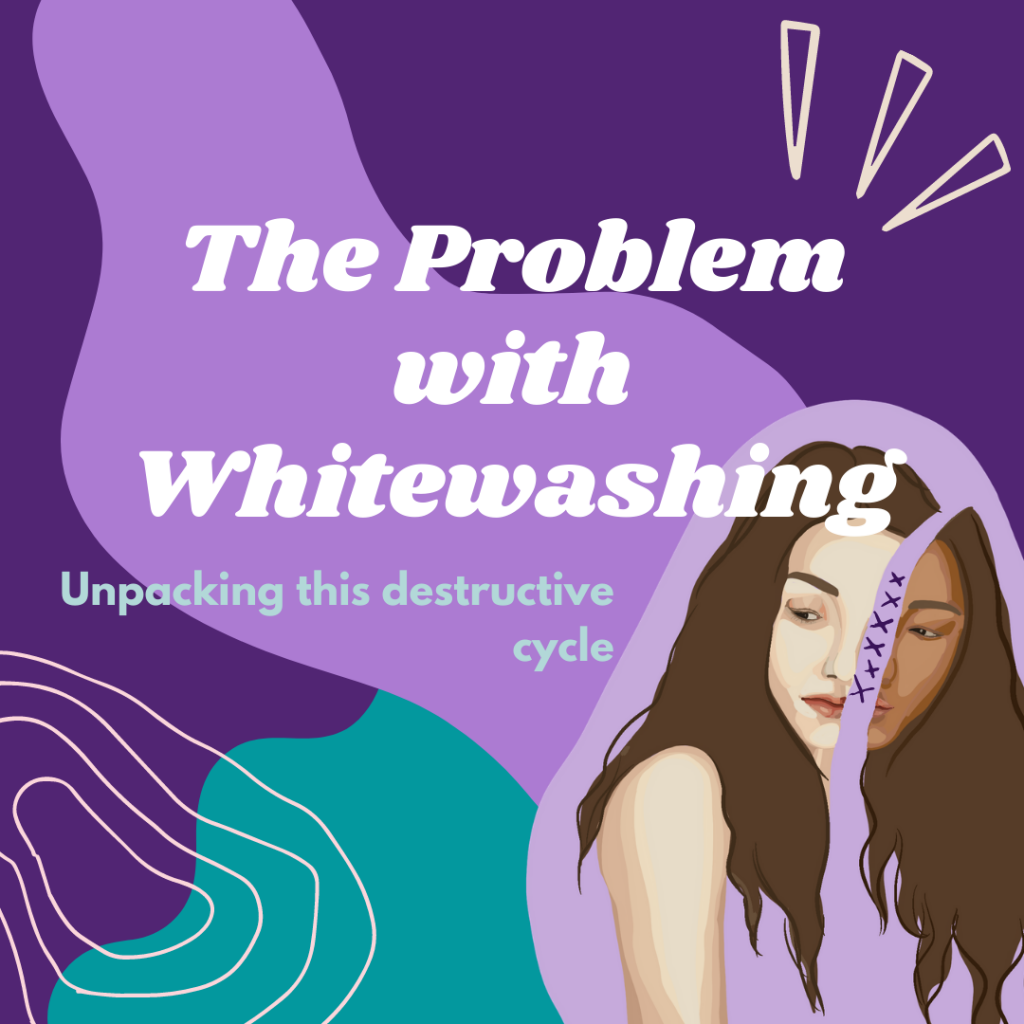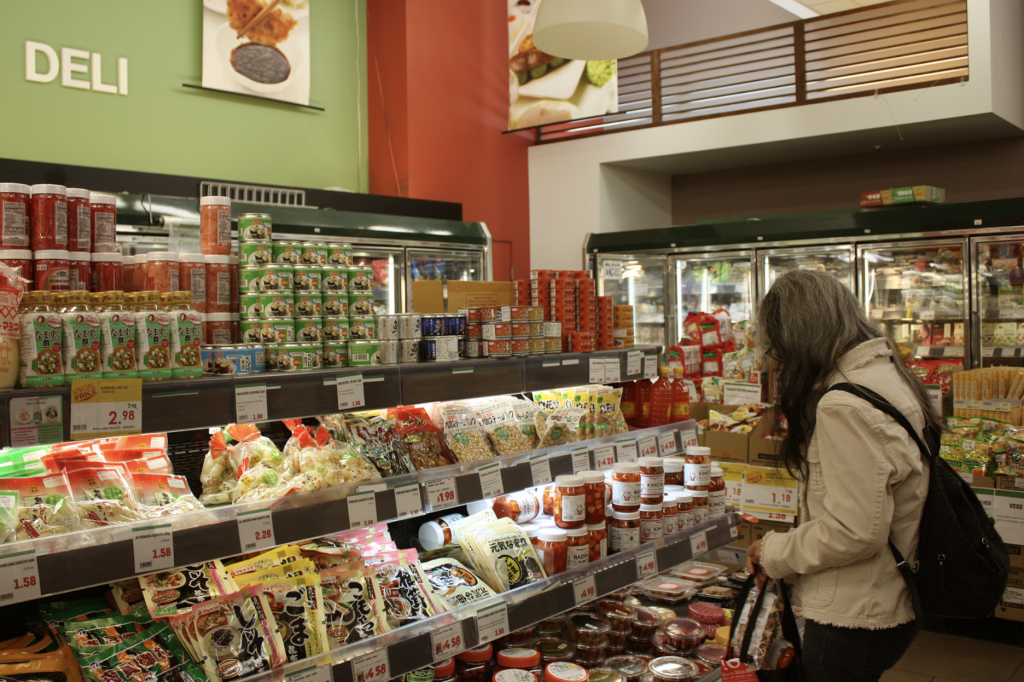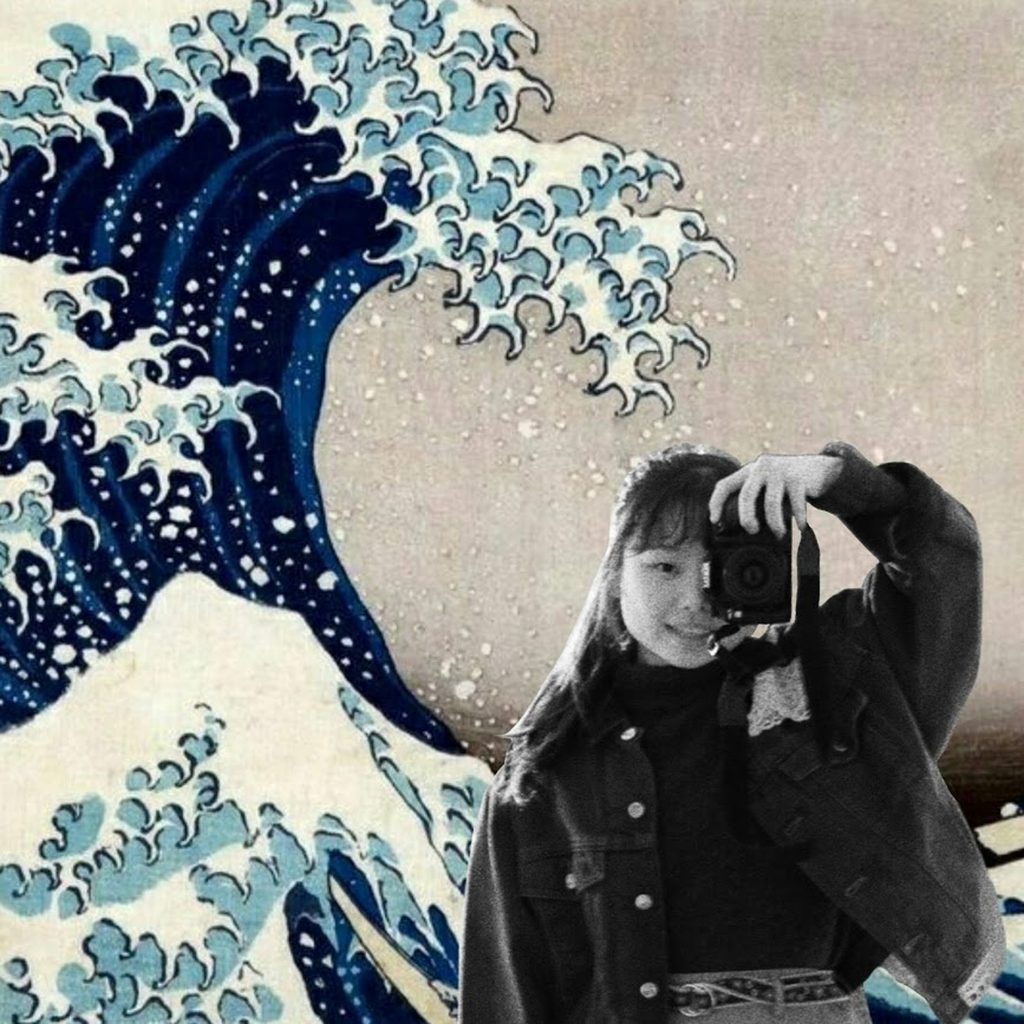Whitewashing. As an Asian, it’s a term that comes up endlessly in one’s fight for visibility in Western society. Paler skin and eurocentric features are praised on social media, culture is mocked and appropriated. So widely observed and extremely complex, it is important that the community can identify the harms of what this term in itself enforces and the destructive cycle that so many Asians living in a White-dominated society are sucked into because of this long-standing occurrence.
“Whitewashing” boils down to the phenomenon of assimilation to Westernization, the erasure of native culture and its replacement with characteristics more suitable and digestible for the public of a Western-dominated society. It is most visible in countries where Western culture has the most influence over an area or state, no matter how diverse the population may be.
English is the most spoken language in the world, with almost 1.13 billion speakers. This influence of language alone is enough to kickstart the cycle of “whitewashing” due to the mere presence of a characteristic distinct to Western culture, not to mention countries with this significant dominance over different cultures and diversity in their populations. Any place in which Asians are not the majority — the United States, United Kingdom, Canada, and more — are all areas where Asian individuals are vulnerable to “whitewashing.”
Western colonialism and imperialism affected Asian countries on every scale. It introduced western ideas like nationalism, democracy, and constitutionalism, forcing these ideals onto the places they conquered and colonized. They pushed their economic ventures onto the existing and thriving conditions of Asian societies, replacing rich and diverse fields of India with limited productions of cash crops that would inevitably benefit the mother country, England. The Spaniards imposed Catholicism on the Philippines and enforced European ways of life. Christian missionaries from all across Europe slowly began to filter into Asia, preaching salvation from sin, encouraging the turn to Christianity and the rejection of native religion. Asians were schooled and taught English, forced to assimilate to Western dress, food, and culture, and were essentially labeled powerless in a country that was once theirs to own. While the Age of Imperialism was classed over a century ago, its impacts on the native populations have been detrimental.
The enforcement of Western ideals may not be as apparent and aggressive as they were decades ago, but its enforcement is unmistakable nonetheless. The guilt around identifying with Asian culture has persevered through generations. Racial segregation in these colonies all those years ago has eternally engrained a sense of inferiority in Asians when in the face of their white counterparts, no matter how much society as a whole may have seemed to digress from it. Western colonialism still has Asian communities in a chokehold, suffocating them until they succumb to Western influence.
The term “whitewashing,” just in itself, automatically gives the impression that anything that is not considered “white” cannot be beneficial to the individual that possesses these characteristics, nor society as a whole. It enforces a phenomenon onto Asian individuals, who already struggle with cultural and self-identity in itself merely existing in Western society, that being white and appealing to Western ideals should be the norm. It enforces the idea that assimilation is the goal, that Westernization should be the standard for acceptance into society. It highlights things like paler skin and eurocentric beauty standards — small nose, big eyes, etc., spoken English, and engaging in traditions and activities that are predominantly considered “American” or “Western.” In “whitewashing,” white is the default. White is good.
“Whitewashing” enforces the idea of applauding BIPOC when they speak, act, or look a certain way that is desirable to the general public (aka in a “white” way). When Asians live in a society that praises those who seem to fit in or identify more with these aspects of Western culture, it only perpetuates the rejection of that person’s own culture and the traditions/characteristics that identify with their cultural group through significant influence. Asians in a Western world feel pressure to engage in activities or change their appearances that make them seem more “white” and closer to appealing to this norm. This is the first phase of the cycle: shame towards one’s own culture and increased insecurity as they assimilate.
There is the need to distance themselves from any aspect of Asian culture: cringing when their native language is spoken, pushing away Asian dishes, refusal to dress in traditional clothes, or engage in traditional activities. These things are different from Western culture, therefore a negative connotation is automatically attached to it. With the looming influence and pressure of this “whiteness” norm, those in the face of Western society inevitably attach this negativity with having cultural pride. To gain acceptance, these negative aspects must be turned away and “whiteness” must take its place: replacing their native language with precisely annunciated English, replacing their cultural dishes with a cheeseburger or a hot dog, replacing Asian dress and tradition with Americanized fashion and holidays.
It proves even more difficult to Asians and almost ironic because as much as one rejects their own culture and becomes more “whitewashed,” it becomes known that this standard of Westernization will always be unreachable. They will never be truly accepted, no matter how many Asian aspects of their lives are replaced with “Americanized” ones. It is impossible for the Asian community members to feel completely comfortable assimilating into “white” norms without feeling some sort of shame towards Asian culture or shame within themselves.
It is an illusion that the West has painted for BIPOC, that somehow one could feel more accepted and included if they rejected their own culture. Asians, or any BIPOC, will never reach this “level” of Westernization deemed acceptable for inclusion. They will never truly be appreciated by the Western world because as much as they distance themselves from Asian culture, they will always be tied to it. They will never be truly part of Western society, no matter how much their own culture is rejected.
Whitewashing sets the Asian community up for failure and insecurity. The inability to find solace in acting “white,” counteracted with the inability to find solace in Asian culture, keeps Asians stuck in a middle ground of confusion and self-reproach.
Whitewashing pushes Asians to reject their own cultures and long for one that will always reject them.
If this shame isn’t enough, the term “whitewashed” can then be weaponized against Asians that have tried to assimilate and identify with the West by members of their own communities. Asians who have fallen into this cycle face even more rejection from the Asian community because they can no longer feel pride and acceptance in simply being Asian. A term that encourages Westernization and identification with “whiteness” — that, in a white society, has extremely positive connotations — is suddenly something negative, something to be ashamed of. This is the second phase of the cycle: the other side of the coin, where being “whitewashed” isn’t something to be proud of, and Asians are rejected and mocked by the Asian community for doing something so feeble and foolish as to assimilate and distance themselves from Asian culture and traditions.
Asian youth mock other Asians for being “whitewashed.” They mock them for not being able to know their native language, for not enjoying their cultural dishes, for not engaging or knowing about their cultural traditions. This phenomenon, as observed, is extremely hypocritical, which only confuses those experiencing whitewashing even further. Not only is their guilt enforced by Western society because one does not match their norms because they are Asian, but there is also guilt enforced from their own cultures because they are Asian and still refuse to identify with it.
Notice how this remorse comes from both internal and external influences. This guilt from phase one factors into feelings of hatred for oneself and their culture can grow into internalized racism, resulting in self-sabotage and cultural guilt. Phase two is guilt because they aren’t in touch with their culture, because they have assimilated. The two contradict, but it is a frequent occurrence that these sources of affliction go hand-in-hand in Asian individuals and BIPOC in general. One is faced with the dilemma of identifying with their own culture or Western culture, both of which result in no solace nor inclusion from either side when one is BIPOC and living in a white-dominated society.
Suppose one identifies fully with their own Asian culture. In that case, there will inevitably be backlash from Western society. We have seen it time and time again and maybe have experienced it ourselves — bullying, racism, mocking. If one attempts to identify with Western culture, there will also be an inevitability of backlash from their own culture. It leaves Asian individuals wondering where they can find acceptance and inclusion if there will always be that inevitability of guilt perpetuated by themselves or the people around them.
When one is “whitewashed,” it can be impossible for them to feel any comfortability when identifying with their own culture because Western society has deemed it far from the “norm” (and therefore a negative thing). Yet, they can’t find any comfortability in identifying with “whiteness” either, because they are stuck under the illusion that they will be accepted when they really can’t. Having the term “whitewashed” used against them by members of their cultural community only worsens that insecurity. Identifying with Western culture, deemed as good by white society, can suddenly become something they should be ashamed of. The two opposing mindsets constantly battle, leaving one in bewilderment of whether cultural pride or cultural shame is a positive thing because no matter what an individual chooses, they will always encounter denial from one group or the other.
Why is identifying with my own culture a good thing in the eyes of my own cultural group, but something to be ashamed of in the eyes of Western society? And why is being “white” supposed to be good in the Western world, but my own culture rejects it?
Being under the influence of two cultural groups that are so incredibly contradictory creates an impossible interface, leaving Asians living in a Western world lost in what society wants of them.
Being too Asian is a source of rejection from Western society, while being not Asian enough is a source of rejection from their own culture.
With so many Asians neck-deep in an identity crisis due to these insecurities surrounding their cultures, it doesn’t help that popular culture tends to romanticize and appropriate characteristics of Asian culture. The same characteristics that the whole phenomenon of “whitewashing” seems to condemn constantly. This is phase three: the pushing of these thin boundaries between what is accepted and what is shunned, only amplifying the confusion from Asians stuck in this gray area between Western and native culture.
Hundreds of fashion brands and designers have appropriated aspects of Asian dress into their own collections without paying tribute to these designs’ origin. Labeled “oriental fashion,” it takes away the traditional and cultural importance of these pieces and hurls them into a whirlwind of fast-changing trends, showing Asian fashion as another mere dress style that can be easily displaced when no longer considered “trendy.” Many of these designs go on to fetishize Asian culture and dress.
Celebrities like Kendall Jenner and Bella Hadid are known for popularizing this slanted, “snatched” eye look by getting thread lifts to pull up their brow line, encouraging a surge in the “fox eye” trend as influencers on social media proceeded to pull their eyes back with their hands to achieve this angular illusion. While the context of this trend is subjective, many Asians agree that a line is crossed when non-Asian influencers manually tug their eyes back to purposely mimic this predominantly Asian feature, especially when the action brings up memories of bullying from one’s youth, when non-Asian peers would pull their eyes back and sneer some (incredibly offensive) racial slur.
When one sees white celebrities and influencers practicing yellowface, blackfishing, or any type of cultural appropriation, it creates an extremely hypocritical scenario in which characteristics or traits that the Asian community (or any BIPOC community) has been mocked for in the past is suddenly “exotic,” but only to the point that is digestible for society as a whole.
While Asians have experienced major mockery and backlash for embracing their cultural identities, Western culture gives itself the authority to appropriate these things for non-Asians or non-BIPOC to enjoy temporarily, to get a glimpse of these non-Western, “exotic” staples of culture that exceeds this “whiteness” norm. It skirts a thin line, yet just enough that it can still be appreciated and praised by white society.
Western society can accept traditional Asian dress and kimonos, but only when a White model can wear it on a runway and be sold for profit, not when it is worn by members of the cultural group where the very designs originated from. When it is in the context of non-Western culture, it suddenly doesn’t adhere to the Western “norm” that whitewashing encourages.
Asians are left helpless when they see these watered-down versions of the culture they were told it was best to reject suddenly being praised, being “trendy.” Everything that whitewashing is enforcing, this standard of “whiteness” deemed above and desirable for those that are not White, is morphed into a norm that picks and chooses what aspects of culture it can steal and use. It holds Asians hostage, it asserts every authority and right for itself to take whatever it pleases while keeping the real Asian cultures it takes from as undesirable, as below the Western standard. It can cherry-pick the aspects of the culture it told Asians to distance themselves from and deem those aspects as part of their norm, just temporarily, before the trends shift and that aspect is back to being outside of that norm.
It is frustrating to see things BIPOC have been made fun of in years prior is something that can be used when “trendy” and disposed of when not, especially when their struggle with self-identity in the face of Westernization is one that is eternal. Trends can come and go, but cultural insecurity is something that never can until these harmful standards have been dismantled.
Asians are living in a society where “white” and “American” are deemed best. Yet, the term “whitewashed” is weaponized against them by their own cultural communities when they speak, look, or act in a way that is considered more “white.” Then, aspects of their own culture that they feel pressure to reject due to colonization are hypocritically romanticized and appropriated by Western media, which only perpetuates confusion and insecurity in BIPOC identity.
It amounts to a cycle of incessant struggle and crisis in an Asian individual’s sense of self and sense of cultural identity. They can identify with their culture — but not too much, or else it exceeds the “whiteness” norm. They can identify with Western culture or try to — but not too much, or else they’ll face rejection from their own cultural group. It is impossible for them to feel accepted and safe in one identity because of the inevitability of guilt charged by the looming influence of the other.
Breaking the Cycle
The most vital step in breaking this endless struggle for self-identity as an Asian in a Western world is acknowledging that this “whiteness” norm stems from years of imperialism and assimilation, as Asian countries millenia ago were colonized and forced under the influence of colonization. The goal of assimilation was enforced so long ago and still has maintained its influence, even to the 21st century. We cannot undo the past, but we can learn and grow from it. As the youth, we have the power to shift the narrative away from whiteness at its center and include the stories of Asians and all BIPOC.
Whitewashing enforces the norm of whiteness. But it doesn’t have to. For years, we have succumbed to assimilation, and cultural shame has trickled down through generations. But it doesn’t have to, not now. We are aware of the destructive standards of having whiteness as the standard, and with that information, we have the tools and the right mindsets to dismantle it.
Breaking the cycle starts with ending the shame surrounding Asian culture, and rebuilding connection and pride between individuals and their cultural groups. It will not be an overnight change. It may take years for society as a whole to collectively debunk and override this “whiteness” norm. But this norm doesn’t have to be something unreachable, something impossible as Asians in a Western world. We are already the norm. Cultural pride can be the norm.
Sources
https://www.huffpost.com/entry/fox-eye-makeup-trend-racist-asians_l_5f3ea97cc5b6305f3254b124
https://www.worldatlas.com/articles/most-popular-languages-in-the-world.html
Cover Image: “REMINISCE” by Allison Chan https://www.pinterest.com/pin/302585668704624756/
Edited by Karina Fathani




